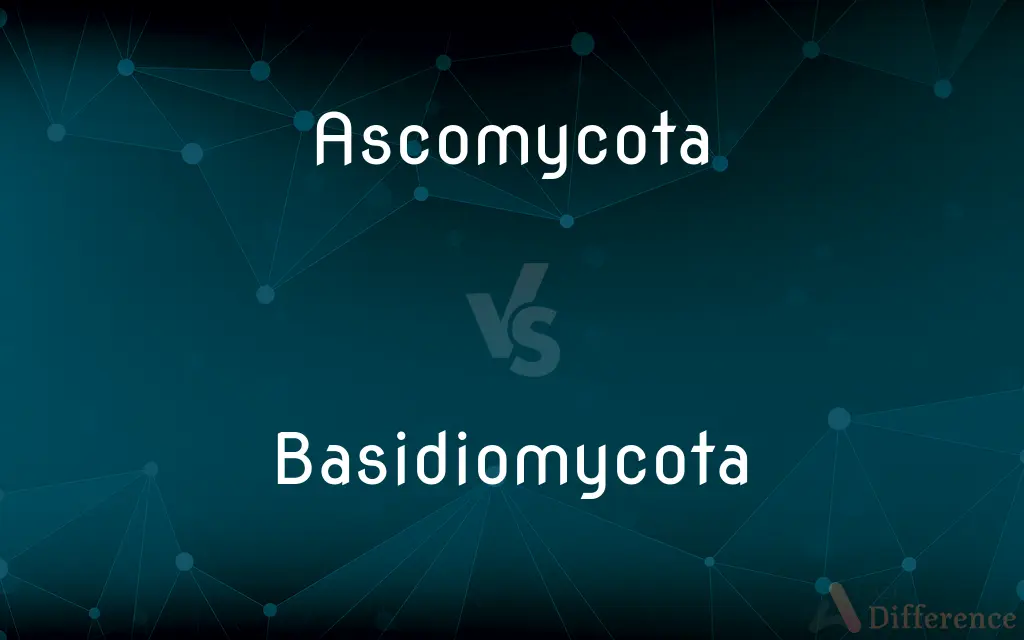Ascomycota vs. Basidiomycota — What's the Difference?
Edited by Tayyaba Rehman — By Urooj Arif — Updated on April 17, 2024
Ascomycota primarily produces spores in sac-like structures called asci, focusing on reproduction; Basidiomycota forms spores on club-shaped structures known as basidia, often observed in mushrooms.

Difference Between Ascomycota and Basidiomycota
Table of Contents
ADVERTISEMENT
Key Differences
Ascomycota, also known as sac fungi, contain their spores in specialized sacs called asci, which typically hold eight spores each. In contrast, Basidiomycota, or club fungi, bear their spores externally on the surface of basidia, which are usually four spores per basidium. This structural difference is key to their reproductive strategies.
Ascomycota encompasses a wide range of species including yeasts, molds, and morels, making them diverse in form and function. Whereas Basidiomycota includes mushrooms, puffballs, and shelf fungi, known for their large, often conspicuous fruiting bodies that are important in forest ecosystems for their role in decomposing wood and other organic materials.
Ascomycota species are often pathogenic to plants and other organisms, including humans, causing diseases like athlete's foot and candidiasis. Conversely, Basidiomycota are more commonly found as decomposers or mycorrhizal partners, forming symbiotic relationships with plants to enhance nutrient absorption.
Economically, Ascomycota are significant for their role in fermentation processes, producing products like bread, beer, and cheese. Basidiomycota, while also used in fermentation, are primarily celebrated for their edible mushrooms and in biotechnological applications such as bioremediation.
Comparison Chart
Spore Container
Asci (internal)
Basidia (external)
ADVERTISEMENT
Spore Number
Typically 8 per asci
Typically 4 per basidium
Common Forms
Yeasts, molds, morels
Mushrooms, puffballs, shelf fungi
Ecological Role
Pathogenic, fermentative
Decomposers, mycorrhizal, bioremediation
Compare with Definitions
Ascomycota
A division of fungi that produces spores in sac-like asci.
The yeast used in baking is a type of Ascomycota.
Basidiomycota
A division of fungi characterized by spore production on basidia.
Most common mushrooms are part of the Basidiomycota division.
Ascomycota
A key process in the life cycle of Ascomycota fungi.
Ascomycota undergo reproduction through the formation of asci.
Basidiomycota
A type of mushroom in the Basidiomycota division.
Puffballs release spores when pressed.
Ascomycota
The spore-producing structure of Ascomycota fungi.
Each ascus typically contains eight spores.
Basidiomycota
The spore-bearing structure of Basidiomycota fungi.
Each basidium typically produces four spores.
Ascomycota
Edible fungi belonging to the Ascomycota division.
Morels are highly prized by gourmet chefs for their unique flavor.
Basidiomycota
Symbiotic associations between Basidiomycota fungi and plants.
Basidiomycota enhance plant growth by improving nutrient uptake.
Ascomycota
Ascomycota is a phylum of the kingdom Fungi that, together with the Basidiomycota, forms the subkingdom Dikarya. Its members are commonly known as the sac fungi or ascomycetes.
Basidiomycota
Basidiomycota () is one of two large divisions that, together with the Ascomycota, constitute the subkingdom Dikarya (often referred to as the "higher fungi") within the kingdom Fungi. Members are known as Basidiomycetes.
Ascomycota
A phylum of higher fungi, coextensive with the class Ascomycetes. It comprises Hemiascomycetes; Plectomycetes; Pyrenomycetes; Discomycetessac fungi; in some classification systems it is considered a division of the kingdom Fungi.
Basidiomycota
A large subdivision of the kingdom Fungi coextensive with the phylum Basidiomycetes, characterized by having the spores borne on a basidium. It embraces those fungi best known to the public, such as mushrooms, toadstools, etc. Among the classes of the Basidiomycota are: Gasteromycetes (puffballs); Tiliomycetes (comprising the orders Ustilaginales (smuts) and Uredinales (rusts)); and Hymenomycetes (mushrooms; toadstools; agarics; bracket fungi).
Ascomycota
A large subdivision of Eumycota including Hemiascomycetes and Plectomycetes and Pyrenomycetes and Discomycetes; sac fungi; in some classification systems considered a division of the kingdom Fungi
Basidiomycota
Comprises fungi bearing the spores on a basidium; includes Gasteromycetes (puffballs) and Tiliomycetes comprising the orders Ustilaginales (smuts) and Uredinales (rusts) and Hymenomycetes (mushrooms, toadstools, agarics and bracket fungi); in some classification systems considered a division of kingdom Fungi
Common Curiosities
What are the typical spore counts in the reproductive structures of Ascomycota and Basidiomycota?
Ascomycota typically produce 8 spores per ascus, whereas Basidiomycota generally produce 4 spores per basidium.
Are Ascomycota or Basidiomycota more diverse in their forms?
Both divisions are highly diverse, but Ascomycota exhibit a wider range of forms including both unicellular and multicellular organisms.
How do Ascomycota and Basidiomycota contribute to the environment?
Ascomycota often act as pathogens and decomposers, while Basidiomycota primarily function as decomposers and form mycorrhizal relationships that help in nutrient cycling in ecosystems.
What unique structural features differentiate Ascomycota from Basidiomycota?
Ascomycota spores are contained within asci, a sac-like structure, while Basidiomycota spores are borne on the outside of basidia, a club-shaped structure.
What are the conservation implications of studying Ascomycota and Basidiomycota?
Studying these fungi helps in understanding their roles in biodiversity and ecosystem health, guiding conservation efforts especially in forest ecosystems.
What types of fungi are included in Ascomycota and Basidiomycota?
Ascomycota includes yeasts, molds, and morels, while Basidiomycota encompasses mushrooms, puffballs, and shelf fungi.
What is the economic significance of Ascomycota and Basidiomycota?
Ascomycota are crucial in the fermentation industry for products like bread and beer, while Basidiomycota are important for edible mushrooms and their use in bioremediation.
Which division is more likely to form symbiotic relationships with plants?
Basidiomycota are more commonly involved in symbiotic relationships, particularly through forming mycorrhizae with plant roots.
How are Ascomycota and Basidiomycota studied in science?
They are studied through ecological, genetic, and biochemical methods to understand their roles in ecosystems, their evolutionary biology, and their utility in industry.
How do Ascomycota and Basidiomycota impact human health?
Ascomycota can be pathogenic, causing infections like athlete's foot and candidiasis, whereas Basidiomycota are less commonly pathogenic and are mostly known for their edible mushrooms.
Can Ascomycota and Basidiomycota be used in biotechnology?
Yes, both are used in biotechnology; Ascomycota in the production of enzymes and pharmaceuticals, and Basidiomycota in bioremediation and sustainable agriculture practices.
Share Your Discovery

Previous Comparison
Asymmetry vs. Unsymmetry
Next Comparison
Marten vs. OtterAuthor Spotlight
Written by
Urooj ArifUrooj is a skilled content writer at Ask Difference, known for her exceptional ability to simplify complex topics into engaging and informative content. With a passion for research and a flair for clear, concise writing, she consistently delivers articles that resonate with our diverse audience.
Edited by
Tayyaba RehmanTayyaba Rehman is a distinguished writer, currently serving as a primary contributor to askdifference.com. As a researcher in semantics and etymology, Tayyaba's passion for the complexity of languages and their distinctions has found a perfect home on the platform. Tayyaba delves into the intricacies of language, distinguishing between commonly confused words and phrases, thereby providing clarity for readers worldwide.
















































